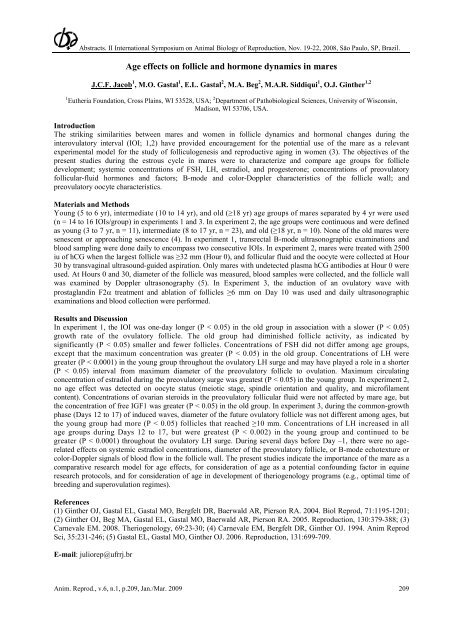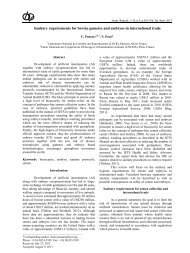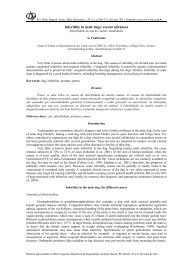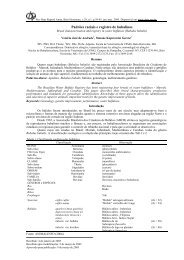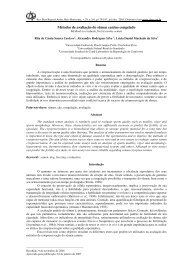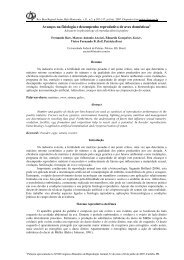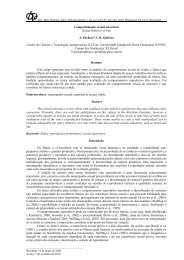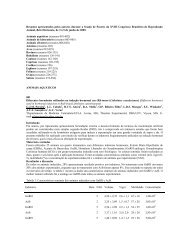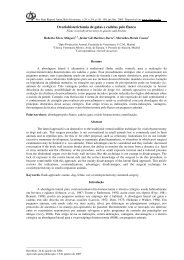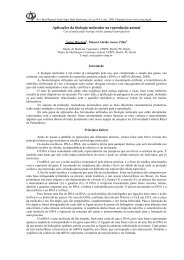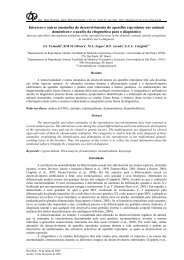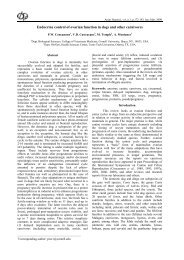Recent advances in ovulation synchronization and superovulation in ...
Recent advances in ovulation synchronization and superovulation in ...
Recent advances in ovulation synchronization and superovulation in ...
Create successful ePaper yourself
Turn your PDF publications into a flip-book with our unique Google optimized e-Paper software.
Abstracts. II International Symposium on Animal Biology of Reproduction, Nov. 19-22, 2008, São Paulo, SP, Brazil.<br />
Age effects on follicle <strong>and</strong> hormone dynamics <strong>in</strong> mares<br />
J.C.F. Jacob 1 , M.O. Gastal 1 , E.L. Gastal 2 , M.A. Beg 2 , M.A.R. Siddiqui 1 , O.J. G<strong>in</strong>ther 1,2<br />
1 Eutheria Foundation, Cross Pla<strong>in</strong>s, WI 53528, USA; 2 Department of Pathobiological Sciences, University of Wiscons<strong>in</strong>,<br />
Madison, WI 53706, USA.<br />
Introduction<br />
The strik<strong>in</strong>g similarities between mares <strong>and</strong> women <strong>in</strong> follicle dynamics <strong>and</strong> hormonal changes dur<strong>in</strong>g the<br />
<strong>in</strong>terovulatory <strong>in</strong>terval (IOI; 1,2) have provided encouragement for the potential use of the mare as a relevant<br />
experimental model for the study of folliculogenesis <strong>and</strong> reproductive ag<strong>in</strong>g <strong>in</strong> women (3). The objectives of the<br />
present studies dur<strong>in</strong>g the estrous cycle <strong>in</strong> mares were to characterize <strong>and</strong> compare age groups for follicle<br />
development; systemic concentrations of FSH, LH, estradiol, <strong>and</strong> progesterone; concentrations of preovulatory<br />
follicular-fluid hormones <strong>and</strong> factors; B-mode <strong>and</strong> color-Doppler characteristics of the follicle wall; <strong>and</strong><br />
preovulatory oocyte characteristics.<br />
Materials <strong>and</strong> Methods<br />
Young (5 to 6 yr), <strong>in</strong>termediate (10 to 14 yr), <strong>and</strong> old (≥18 yr) age groups of mares separated by 4 yr were used<br />
(n = 14 to 16 IOIs/group) <strong>in</strong> experiments 1 <strong>and</strong> 3. In experiment 2, the age groups were cont<strong>in</strong>uous <strong>and</strong> were def<strong>in</strong>ed<br />
as young (3 to 7 yr, n = 11), <strong>in</strong>termediate (8 to 17 yr, n = 23), <strong>and</strong> old (≥18 yr, n = 10). None of the old mares were<br />
senescent or approach<strong>in</strong>g senescence (4). In experiment 1, transrectal B-mode ultrasonographic exam<strong>in</strong>ations <strong>and</strong><br />
blood sampl<strong>in</strong>g were done daily to encompass two consecutive IOIs. In experiment 2, mares were treated with 2500<br />
iu of hCG when the largest follicle was ≥32 mm (Hour 0), <strong>and</strong> follicular fluid <strong>and</strong> the oocyte were collected at Hour<br />
30 by transvag<strong>in</strong>al ultrasound-guided aspiration. Only mares with undetected plasma hCG antibodies at Hour 0 were<br />
used. At Hours 0 <strong>and</strong> 30, diameter of the follicle was measured, blood samples were collected, <strong>and</strong> the follicle wall<br />
was exam<strong>in</strong>ed by Doppler ultrasonography (5). In Experiment 3, the <strong>in</strong>duction of an ovulatory wave with<br />
prostagl<strong>and</strong><strong>in</strong> F2α treatment <strong>and</strong> ablation of follicles ≥6 mm on Day 10 was used <strong>and</strong> daily ultrasonographic<br />
exam<strong>in</strong>ations <strong>and</strong> blood collection were performed.<br />
Results <strong>and</strong> Discussion<br />
In experiment 1, the IOI was one-day longer (P < 0.05) <strong>in</strong> the old group <strong>in</strong> association with a slower (P < 0.05)<br />
growth rate of the ovulatory follicle. The old group had dim<strong>in</strong>ished follicle activity, as <strong>in</strong>dicated by<br />
significantly (P < 0.05) smaller <strong>and</strong> fewer follicles. Concentrations of FSH did not differ among age groups,<br />
except that the maximum concentration was greater (P < 0.05) <strong>in</strong> the old group. Concentrations of LH were<br />
greater (P < 0.0001) <strong>in</strong> the young group throughout the ovulatory LH surge <strong>and</strong> may have played a role <strong>in</strong> a shorter<br />
(P < 0.05) <strong>in</strong>terval from maximum diameter of the preovulatory follicle to <strong>ovulation</strong>. Maximum circulat<strong>in</strong>g<br />
concentration of estradiol dur<strong>in</strong>g the preovulatory surge was greatest (P < 0.05) <strong>in</strong> the young group. In experiment 2,<br />
no age effect was detected on oocyte status (meiotic stage, sp<strong>in</strong>dle orientation <strong>and</strong> quality, <strong>and</strong> microfilament<br />
content). Concentrations of ovarian steroids <strong>in</strong> the preovulatory follicular fluid were not affected by mare age, but<br />
the concentration of free IGF1 was greater (P < 0.05) <strong>in</strong> the old group. In experiment 3, dur<strong>in</strong>g the common-growth<br />
phase (Days 12 to 17) of <strong>in</strong>duced waves, diameter of the future ovulatory follicle was not different among ages, but<br />
the young group had more (P < 0.05) follicles that reached ≥10 mm. Concentrations of LH <strong>in</strong>creased <strong>in</strong> all<br />
age groups dur<strong>in</strong>g Days 12 to 17, but were greatest (P < 0.002) <strong>in</strong> the young group <strong>and</strong> cont<strong>in</strong>ued to be<br />
greater (P < 0.0001) throughout the ovulatory LH surge. Dur<strong>in</strong>g several days before Day –1, there were no agerelated<br />
effects on systemic estradiol concentrations, diameter of the preovulatory follicle, or B-mode echotexture or<br />
color-Doppler signals of blood flow <strong>in</strong> the follicle wall. The present studies <strong>in</strong>dicate the importance of the mare as a<br />
comparative research model for age effects, for consideration of age as a potential confound<strong>in</strong>g factor <strong>in</strong> equ<strong>in</strong>e<br />
research protocols, <strong>and</strong> for consideration of age <strong>in</strong> development of theriogenology programs (e.g., optimal time of<br />
breed<strong>in</strong>g <strong>and</strong> super<strong>ovulation</strong> regimes).<br />
References<br />
(1) G<strong>in</strong>ther OJ, Gastal EL, Gastal MO, Bergfelt DR, Baerwald AR, Pierson RA. 2004. Biol Reprod, 71:1195-1201;<br />
(2) G<strong>in</strong>ther OJ, Beg MA, Gastal EL, Gastal MO, Baerwald AR, Pierson RA. 2005. Reproduction, 130:379-388; (3)<br />
Carnevale EM. 2008. Theriogenology, 69:23-30; (4) Carnevale EM, Bergfelt DR, G<strong>in</strong>ther OJ. 1994. Anim Reprod<br />
Sci, 35:231-246; (5) Gastal EL, Gastal MO, G<strong>in</strong>ther OJ. 2006. Reproduction, 131:699-709.<br />
E-mail: juliorep@ufrrj.br<br />
Anim. Reprod., v.6, n.1, p.209, Jan./Mar. 2009 209


